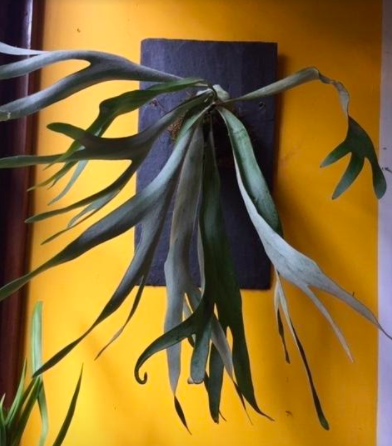
-Pam Scott-
Of all the beautiful tropical houseplants we offer at Fifth Season Gardening, I find the Staghorn Fern (Platycerium) to be the most strikingly dramatic. When mounted and hung on a wall, the Staghorn Fern becomes more of a living sculpture than a houseplant.
With Staghorns, as with all tropical plants, it is helpful to know how and where the plant grows in its natural habitat in order to maintain its optimal health. Staghorn Ferns are epiphytes, as are air plants and most orchids. They make their homes not in soil but on the trunks and limbs of trees and other plants. They thrive in warm humid environments, with temperatures ideally between 55 and 90 degrees F. Because they grow in trees, they are always surrounded by a leafy canopy and bright, indirect light.
The main function of a Staghorn’s roots is to anchor the plant onto their host tree. They live off of rainwater and humidity, absorbed through their base and antler-like upright fronds. Staghorns get their nutrients from decomposing leaf debris, dead insects, as well as bird guano, which are absorbed through their fronds.
The basal frond is the shield that grows around the base of the plant. It starts out as a green disk-like leaf that eventually turns to a papery brown. This papery shield must remain on the plant as it aids in nutrient and moisture absorption as well as protecting the base of the plant. The under sides of the upright antler fronds hold the reproductive structures in the form of tiny spores. The upright fronds are covered with a silvery fuzz which aids in moisture and nutrient collection and retention and must not be removed from the plant.
To simulate the perfect natural growing environment for your Staghorn Fern you will want to provide good air circulation for the roots and fronds, bright indirect light, high humidity and warm temperatures. The Staghorn root base needs to dry out before a thorough watering. A thorough watering can be done by submerging the plant in a bucket of water for 10 minutes. If the tips of the plant are browning this is a sign of under watering. If the bases of the upright fronds are browning that is a sign of over watering.
Your Staghorn will enjoy monthly fertilization with a ¼ strength, slow release, all-natural, liquid fertilizer such as Bio Thrive Grow in spring and summer, every other month in the cooler seasons. You can alternate this fertilizing regime with a fish emulsion as well. Daily misting will help maintain the high humidity your plant requires. Staghorn ferns can be prone to mealybug and scale. This can be removed with horticultural oil on a Q-tip applied to the affected area. A mass infestation can be treated with horticultural oil sprayed throughout the plant, thoroughly rinse the fronds off two days later so the oil does not interfere with the plant’s respiration.
Because Staghorn Ferns grow in trees and their roots and fronds receive plenty of air circulation, the plastic pots that you buy them in are not ideal for their long-term health. Mounting them on boards, bark, driftwood, slate or hanging them in wooden or wire baskets provides the perfect environment for these air-loving epiphytes.
Although mounting Staghorns directly to a board, where they actually grow onto and eventually envelop the board, looks wonderful (you can find many tutorials online to show you how to do this), this mounting technique can be problematic. In order to water the plant you have to water the board as well. No matter how long you let it drain you will still be putting a wet board up on your wall. This is not a problem if you have brick or stone walls, but if you put it up on sheet rock you will end up with a damaged and molded wall. One way to avoid this problem is to create a moss-wrapped root ball and hang it from your mounting material, removing it from the mounting material when you water it.
A simple way to hang your fern from a board:
- Choose an attractive, preferably hardwood, pest-free, non-pressure-treated board that has some character; remember you are creating a sculpture here.
- Put a small screw into the back of the board ⅔ of the way up and a screw ⅔ of the way up on the front of the board.
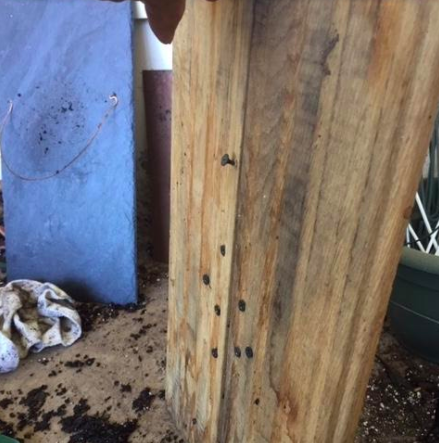
- On the back screw attach a wire loop securely to the screw. Use a fairly heavy gauge wire, as the plant and board will have some weight.
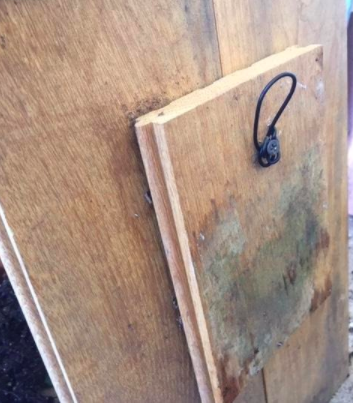
- Decide which position of the plant will be the top.
- Gently remove some of the soil from the root ball of the plant to create a flat base; keep more soil on the lower edge of the root ball so the plant will end up facing upward.
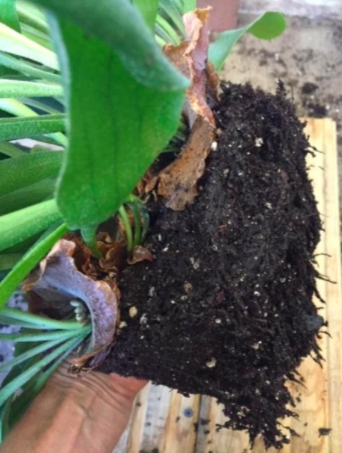
- Wrap the whole root ball with sheet moss, being careful not to damage the basal fronds.
- Secure the moss to the root ball using a 3-4 foot long piece of green 22-gauge spool wire. Starting at the top where you want the fern to hang, leave a tail of wire at the beginning. Wrap the wire around the moss firmly, going a few times around until you come back to where you started. Trim the wire and tie the two ends together; create a secure loop to hang the plant onto the board.
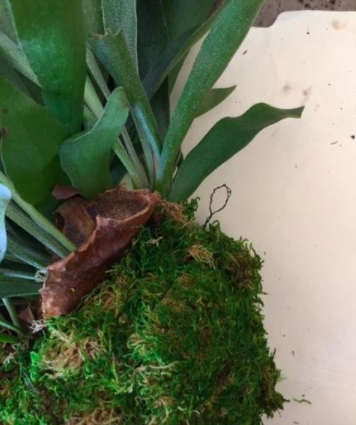
- Hang the plant on the board from the screw, and hang the board on the wall. When you need to water the plant just remove the plant loop from the screw, soak the plant, let it drain thoroughly, and replace it on the screw.
- Here is the finished living sculpture:
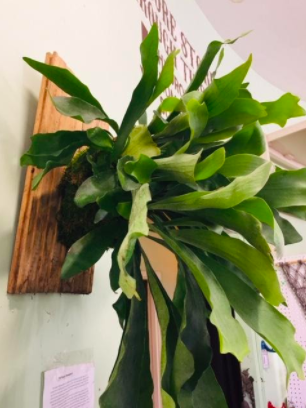
There are many other ways to display your moss-wrapped Staghorn Fern.
Pictured here, we have ours resting in a wire basket:
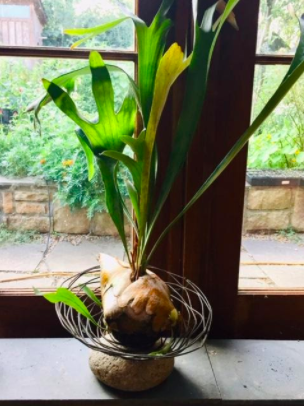
Nestled in the limb of a fallen dogwood branch:
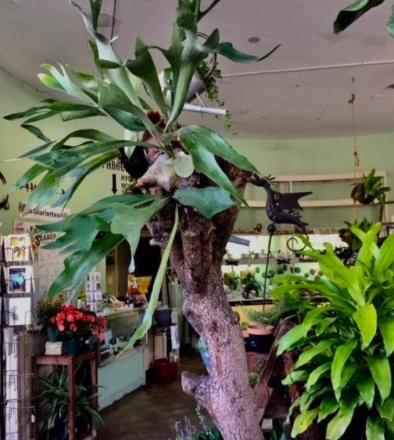
And hanging from a roofing slate:

At Fifth Season Gardening we are always ready to help you with your exciting and creative plant projects!

Gerry Torres says
Very informative, easy to follow hanging instructions .
Melanie Johnston Levy says
I ordered a staghorn fern online thinking I was purchasing a decent-sized plant. What I received was disappointing to say the least…2 small fronds about the size of my thumb. It is still small and has several more fronds but NOTHING like you have pictured on your site. Any tips more more dramatic growth? Thank you.
Sue Jose says
This is very helpful. We have a very large stag horn that had to be removed from its spot in a gum tree where it was very happy. The only place we have to put it now is on a brick wall in a pool area that gets some light but the plant will receive no filtered direct sunlight. Just wanting to know if this will be a problem. Also as it’s so large we plan to put it on a board but it will be too heavy to lift down to get a soaking water. Will this spot be too stressful for the plant?
ashley says
Hi Sue, you can water your fern from above as long as it is a thorough watering; high humidity is beneficial so a pool area will probably be great. Without seeing the light situation its hard to tell what the actual lighting is. The plant may not thrive without a good bright environment, as some filtered direct is preferred. They are very adaptable plants, however, so it may not thrive at first but will probably put out new growth that is better adapted to the different environment. It just may not be as full and lush as it was.
ashley says
Hi Melanie, Ugh! So disappointing! But you may be able to get that fern where you want it. I have found that staghorn ferns unlike other ferns really enjoy a bit of half dose fertilizer. They are generally slow growers but a bit of organic fertilizer will help them to develop some new fronds and shields. Cheers! Pam
Kathy says
This article was very helpful. I received a staghorn fern for Christmas. I have many houseplants but this is by far one of the most beautiful and dramatic and I am clueless. I’m entranced by it’s beauty and hope I can care for it properly. It really is a sculpture.
Peggy says
I purchased a 4” staghorn fern. Not sure why. It’s the variety that does not have bifurcated leaves. The loose soil is mostly dropping off. I’d like to to mount the little guy. How can I replace the dirt ball. How could I make a moss ball, something like kokedama.
ashley says
Hi Peggy, we actually have another blog post that is a great how-to for making a kokedama: https://fifthseasongardening.com/kokedama-lazy-persons-bonsai
Hope this helps!
Charity Bechtel says
Hi How large should the staghorn get before you can or should mount it?
ashley says
Hi Charity, We’d let the staghorn get at least to the size of a 4-inch pot before mounting. Cheers!
Claudia Boyd says
Hello,
We just moved two of our ferns from a potted environment to be fern-wrapped and put on a board. I wish I read your post before yesterday – my husband drilled little holes all around the moss ball and then secured the wire in the back.
I would like to follow your example, simply for the ease of soaking.
Would it be too stressful for the fern to be moved once more?
I appreciate your information.
Thank you
brian says
Thanks for your question. As far as a double move, really the only way to tell if it’s better to do so now vs. later would be to take cues from the plant. If the move is recent enough and your plant hasn’t begun to reestablish itself, you can probably get away with moving it now. If on the other hand, it has spent the energy to reestablish, it would be best to give it several weeks to strengthen before moving it again. Best of luck!
Judith Diaz says
I have a stag horn plant that is hanging from a sycamore tree. It came with the house that I purchased two years ago in Florida. It has grown quite a bit in the two years. My question is How can I get it to stick on the tree rather than keep it hanging from a branch or should I not attempt to do that?
brian says
Thanks for your question. Moving your staghorn is possible, but should be done with care. If today the plant’s roots are entangled with the branch you mentioned, I’d consider leaving it in it’s current location. If not, you could move it to the trunk. Just like we show in the blog post for a wall, a nail with a wire loop on the trunk could be a great solution. Good luck!